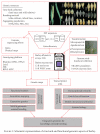Barley genomics: An overview
- PMID: 18382615
- PMCID: PMC2276607
- DOI: 10.1155/2008/486258
Barley genomics: An overview
Abstract
Barley (Hordeum vulgare), first domesticated in the Near East, is a well-studied crop in terms of genetics, genomics, and breeding and qualifies as a model plant for Triticeae research. Recent advances made in barley genomics mainly include the following: (i) rapid accumulation of EST sequence data, (ii) growing number of studies on transcriptome, proteome, and metabolome, (iii) new modeling techniques, (iv) availability of genome-wide knockout collections as well as efficient transformation techniques, and (v) the recently started genome sequencing effort. These developments pave the way for a comprehensive functional analysis and understanding of gene expression networks linked to agronomically important traits. Here, we selectively review important technological developments in barley genomics and related fields and discuss the relevance for understanding genotype-phenotype relationships by using approaches such as genetical genomics and association studies. High-throughput genotyping platforms that have recently become available will allow the construction of high-density genetic maps that will further promote marker-assisted selection as well as physical map construction. Systems biology approaches will further enhance our knowledge and largely increase our abilities to design refined breeding strategies on the basis of detailed molecular physiological knowledge.
Figures
Similar articles
-
Barley genetic variation: implications for crop improvement.Brief Funct Genomics. 2014 Jul;13(4):341-50. doi: 10.1093/bfgp/elu006. Epub 2014 Mar 22. Brief Funct Genomics. 2014. PMID: 24658880
-
TriMEDB: a database to integrate transcribed markers and facilitate genetic studies of the tribe Triticeae.BMC Plant Biol. 2008 Jun 30;8:72. doi: 10.1186/1471-2229-8-72. BMC Plant Biol. 2008. PMID: 18590523 Free PMC article.
-
Barley2035: A decadal vision for barley research and breeding.Mol Plant. 2025 Feb 3;18(2):195-218. doi: 10.1016/j.molp.2024.12.009. Epub 2024 Dec 17. Mol Plant. 2025. PMID: 39690737 Review.
-
A guide to barley mutants.Hereditas. 2024 Mar 8;161(1):11. doi: 10.1186/s41065-023-00304-w. Hereditas. 2024. PMID: 38454479 Free PMC article. Review.
-
Enhancement of Plant Productivity in the Post-Genomics Era.Curr Genomics. 2016 Aug;17(4):295-6. doi: 10.2174/138920291704160607182507. Curr Genomics. 2016. PMID: 27499678 Free PMC article.
Cited by
-
Lipid transfer proteins and protease inhibitors as key factors in the priming of barley responses to Fusarium head blight disease by a biocontrol strain of Pseudomonas fluorescens.Funct Integr Genomics. 2010 Nov;10(4):619-27. doi: 10.1007/s10142-010-0177-0. Epub 2010 Jun 5. Funct Integr Genomics. 2010. PMID: 20526726
-
Use of multiple traits genomic prediction, genotype by environment interactions and spatial effect to improve prediction accuracy in yield data.PLoS One. 2020 May 13;15(5):e0232665. doi: 10.1371/journal.pone.0232665. eCollection 2020. PLoS One. 2020. PMID: 32401769 Free PMC article.
-
The international barley sequencing consortium--at the threshold of efficient access to the barley genome.Plant Physiol. 2009 Jan;149(1):142-7. doi: 10.1104/pp.108.128967. Plant Physiol. 2009. PMID: 19126706 Free PMC article. No abstract available.
-
phiC31 integrase-mediated site-specific recombination in barley.PLoS One. 2012;7(9):e45353. doi: 10.1371/journal.pone.0045353. Epub 2012 Sep 14. PLoS One. 2012. PMID: 23024817 Free PMC article.
-
Unlocking Triticeae genomics to sustainably feed the future.Plant Cell Physiol. 2013 Dec;54(12):1931-50. doi: 10.1093/pcp/pct163. Epub 2013 Nov 6. Plant Cell Physiol. 2013. PMID: 24204022 Free PMC article. Review.
References
-
- Salamini F, Özkan H, Brandolini A, Schäfer-Pregl R, Martin W. Genetics and geography of wild cereal domestication in the near east. Nature Reviews Genetics. 2002;3(6):429–441. - PubMed
-
- Schuster WH. Welchen Beitrag leistet die Pflanzenzüchtung zurLeistungssteigerung von Kulturpflanzenarten. Pflanzenbauwissenschaften. 1997;1:9–18.
-
- Rafalski A. Applications of single nucleotide polymorphisms in crop genetics. Current Opinion in Plant Biology. 2002;5(2):94–100. - PubMed
-
- Varshney RK, Hoisington DA, Tyagi AK. Advances in cereal genomics and applications in crop breeding. Trends in Biotechnology. 2006;24(11):490–499. - PubMed
-
- Wobus U, Sreenivasulu N. Genomics approaches for the improvement of cereals. In: Freitag J, editor. European Training and Networking Activity, Plant Genomics and Bioinformatics Expression Micro Arrays and Beyond—A Course Book. Ljubljana Slovenia: National Institute of Biology; 2006. pp. 146–155.
LinkOut - more resources
Full Text Sources
Research Materials


